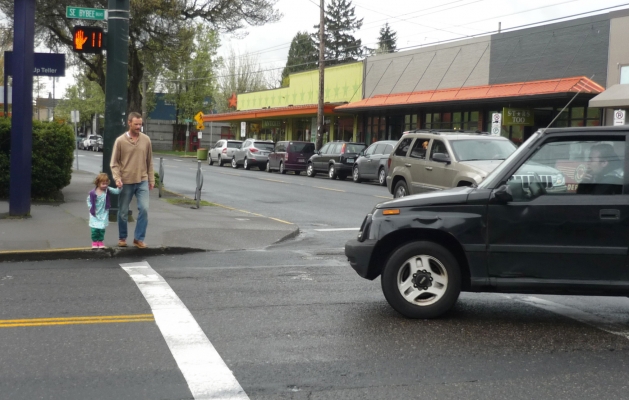Flashing-yellow-arrow research spotlights pedestrian safety risk

Flashing-yellow-arrow traffic signals offer convenience for drivers by permitting them to turn left after yielding to oncoming traffic. This convenience, OTREC research has found, can come at the expense of safety, especially where the traffic mix includes pedestrians.
OTREC researchers David Hurwitz of Oregon State University and Christopher Monsere of Portland State University examined how driver behaviors affect pedestrian safety at flashing yellow arrows. Their findings show that drivers at these intersections often don’t even look for pedestrians.
This research will be the focus of OTREC’s first live interview-style Webinar May 7. Host Steph Routh of Oregon Walks will interview the researcher-practitioner team, explore real-world applications and take audience questions. The Webinar is free. Details are at this link:
Flashing yellow arrows have been replacing other left-turn signals, such as solid green or flashing yellow or red circles, to indicate that drivers may turn after yielding to oncoming traffic. These turns are considered “permissive.” Turns where no conflicting traffic is present, such as those indicated with a green arrow, are “protected” turns. The flashing yellow arrow’s inclusion in the 2009 Manual on Uniform Traffic Control Devices sped up the signal’s adoption to indicate a permissive turn.
After suburban Washington County, Oregon, adopted the flashing yellow arrows at hundreds of intersections, potential pedestrian-vehicle conflicts became an increasing source of safety complaints. The county worked to find a solution that serves both pedestrians and drivers, hiring engineering-and-planning firm Kittelson & Associates, Inc. to implement new traffic-signal logic. The county also participated in the OTREC research project to see whether its approach would be effective.
For the OTREC study, Hurwitz and Monsere used a driving simulator to track where study participants looked and steered a simulated vehicle.In four to seven percent of the cases when pedestrians were present, drivers didn’t focus at all on pedestrians in the crosswalk.
Those who did glance at pedestrians spent less time looking as automobile traffic increased, indicating a challenge to balance multiple tasks. Drivers did pay more attention to pedestrians as the number of pedestrians increased.
Washington County changed the logic in its traffic controller software to reduce conflicts. Now, drivers don’t get a flashing yellow arrow at the same time that pedestrians have a “walk” signal displayed. When pedestrians are present, drivers get the flashing arrow only after the pedestrians have crossed. The OTREC research conclusions confirmed the county’s practice.
This approach strikes a balance between safety and efficiency, the researchers found. By carefully controlling when the flashing yellow arrow is displayed, transportation engineers can foster convenient intersections that protect pedestrians.
In addition, researchers also looked at the configuration of the signals themselves. They found little difference in the response to signals with three heads versus those with four, concluding that the extra cost of four-section signals may not be justified.
More information on the research project is at the following link:
https://nitc.trec.pdx.edu/research/project/484
The project’s draft final report is also available for free download:
http://ppms.trec.pdx.edu/media/project_files/OTREC-RR-13-02%20Final_2.pdf
